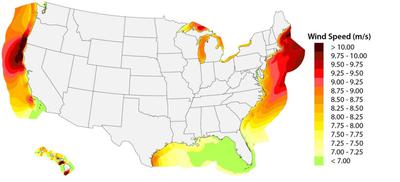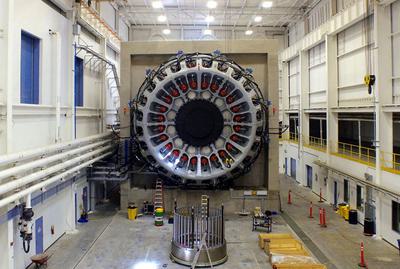Construction advances are allowing wind farms to be built farther offshore, lessening public concern about seeing turbines close to the coast.
“The real nuts-and-bolts of making this industry happen are going to come together in 2018,” says Stephanie McClellan, director of the University of Delaware’s Special Initiative on Offshore Wind.
Several key factors are driving the long-awaited takeoff of U.S. offshore wind: Sophisticated turbine technologies and economies of scale are driving down costs; advances in construction are allowing wind farms to be built in deeper water farther offshore, significantly lessening the public’s concern about seeing turbines close to the coast; states across the Northeast and the mid-Atlantic, as well as California and Hawaii, are pushing development of offshore wind projects; and some European wind turbine manufacturers, as well as several U.S. firms, have decided to locate research, development, and wind turbine production facilities in the U.S.
And to the surprise of some companies and renewable energy analysts, the Trump administration — which has aggressively promoted the development of fossil fuels over renewable energy — seems to be supporting the offshore wind energy sector.
Interior Secretary Ryan Zinke, whose department oversees the federal Bureau of Ocean Energy Management, endorsed offshore wind in his proposed fiscal year 2018 budget and praised the leasing of federal waters to Avangrid for the Kitty Hawk project as a “big win.” In December, U.S. Secretary of Energy Rick Perry announced the creation of a consortium to develop innovative offshore wind technologies. Ninety percent of the announced $18.5 million in federal funding for the consortium will go to research and development, largely to decrease turbine costs and improve turbine efficiency.
President Trump, who once disparaged many aspects of wind power, could still decide to throw up roadblocks to the offshore wind industry. But for now, analysts are cautiously optimistic about the sector’s prospects, especially since Congress’s recently passed tax reform bill preserves tax credits for the wind energy industry for several more years.
U.S. wind energy potential based on average wind speeds at 300 feet, the height of most turbines. The northeastern U.S. and Northern California coasts (in red) have the greatest potential. Graphic by NREL
Bruce Hamilton, director of energy practice at the consulting firm Navigant, has been skeptical of the prospects for U.S. offshore wind energy, in large measure because establishing wind farms offshore has been far more expensive than building onshore facilities. But he now sees encouraging signs of life in the sector, as offshore wind costs have fallen substantially. “European developers, major companies, are interested in participating, and that is telling,” says Hamilton.
Stephen Bull, Statoil’s senior vice president for offshore wind, told The Wall Street Journal last year, “We have done this in Europe, and we have absolutely the same opportunity in the U.S.”
Europe now has a total installed offshore wind capacity of more than 12,600 megawatts (12.6 gigawatts), generated by 3,589 grid-connected wind turbines in 10 countries. The U.K. is the world’s most developed offshore wind market and accounts for about 36 percent of installed capacity, followed by Germany in the second spot, with 29 percent, according to the Global Wind Energy Council. In 2016, China passed Denmark to achieve third place in the offshore rankings with 11 percent. Denmark, now in fourth place, accounts for 8.8 percent of installed global offshore wind capacity. The Netherlands has 7.8 percent, Belgium 5 percent, and Sweden 1.4 percent.
The capital costs of offshore wind generation in Europe are falling sharply, from $3.8 million per megawatt of electricity in 2016, to $2.2 million per megawatt at the end of 2017. The primary driver for these reductions is the increase in turbine capacity, and this ongoing advancement in turbine and platform technology will continue to drive down the cost of offshore wind, according to Hamilton.
“It is incredible how much the costs per megawatt [for offshore wind-generated electricity] have dropped this year alone in Europe,” says Hamilton. “As a result, two projects were bid with zero subsidies that will be built in the mid-[20]20s. That kind of cost improvement will come here, too.”
The offshore wind industry says it is aiming to soon produce electricity at a cost equal to, or lower than, coal or natural gas.
The nascent offshore wind energy sector in the U.S., at least initially, is expected to produce more expensive electricity. According to the U.S. Energy Information Administration, the projected cost of electricity per megawatt-hour in the U.S. in 2022 will be $140 for coal, $110 for natural gas, and $157 for offshore wind — excluding any tax credits, which boost wind power’s competitiveness.
Laura Beane, the CEO of Avangrid Renewables, which is the developer of the Kitty Hawk wind project, says the offshore industry has been preparing to move ahead with offshore wind growth without incentives, such as the federal Production Tax Credit, which is scheduled to be phased out over the next three years under the 2017 federal tax overhaul. Yet Beane says the offshore wind industry is aiming to soon produce electricity at a cost equal to, or lower than, coal or natural gas.
Offshore wind turbines and other components are primarily being produced in Europe and China — with the notable exception of G.E. Renewable Energy, the U.S. turbine manufacturing leader, which has facilities in South Carolina, Florida, and California.
But some companies are beginning to develop advanced offshore wind power technologies in the U.S. For instance, Louisiana-based Keystone Engineering is experimenting with the newest platform foundations designed to anchor turbines at U.S. offshore wind farm sites. The company, rooted in the oil and gas industry, has designed a structure called the “Twisted Jacket” foundation that reduces costs and storm risk compared to other foundations.
Other companies in Texas, Louisiana, and South Carolina are already interested in participating in the new offshore wind industry, according to James F. Manwell, director of the Wind Energy Center at the University of Massachusetts, Amherst. Furthermore, a Denmark-based turbine maker, MHI Vestas, is developing a groundbreaking 9.5-megawatt turbine — reportedly the world’s most powerful — in South Carolina at Clemson University. This powerhouse prototype would likely be used in the first batch of large offshore wind projects built in the U.S., and according to the University of Delaware’s McClellan, the South Carolina facility is an important sign that the offshore wind industry is poised for steady growth in America.
This 9.5-megawatt turbine being built at Clemson University in South Carolina will reportedly be the world's most powerful when completed. Clemson University
Meanwhile, numerous states — including New York, New Jersey, Massachusetts, Delaware, Maryland, Rhode Island, Hawaii, and California — are moving aggressively to develop offshore wind projects:
- In New York, the state’s Clean Energy Standard mandates a significant increase in the share of renewables in its energy mix. As part of that effort, Governor Andrew Cuomo has called for up to 2.4 gigawatts of offshore wind power by 2030, a move that helps create a reliable market for offshore wind-generated power, says Statoil’s Empire Wind project director, Christer af Geijerstam.
- In New Jersey, Democratic Governor-elect Phil Murphy has proposed a strong plan to advance offshore wind initiatives sidelined during the tenure of his predecessor, Republican Chris Christie. During his campaign, Murphy, who takes office January 16, called for developing “the most ambitious offshore wind target in the country” and promised to bring 3.5 gigawatts of offshore wind to the state by 2030.
- Last May, Maryland utility regulators approved two offshore wind farm projects, to be constructed respectively by U.S. Wind and Deepwater Wind, the developer of Block Island Wind. State utility regulators have approved subsidies for these projects.
Statoil is marketing its floating wind turbine technology, already in use globally, to California and Hawaii.
- In Massachusetts, where the controversial Cape Wind project in Nantucket Sound was recently abandoned, the state has been actively trying to develop offshore wind projects. About 15 miles off Martha’s Vineyard, Avangrid, in partnership with Copenhagen Infrastructure Partners, is vying for another federal lease. The state of Massachusetts is requesting utility providers to submit proposals to purchase power from the project, which will be connected to the mainland via buried transmission lines. Massachusetts and Rhode Island have both passed laws that require utilities to enter into long-term contracts, known as power purchase agreements, with economically competitive offshore wind projects.
- In California and Hawaii, efforts are now underway to identify the best locations for offshore wind farms. Statoil is marketing its floating wind turbine technology — already in use globally — to both states. Hawaii is eyeing offshore wind as part of its effort to power the island with 100 percent clean energy by 2045.
- Although exploratory at this time, the Gulf of Mexico is an area of interest for offshore wind development because of the design, infrastructure, and workforce synergies between offshore wind and the Gulf’s oil and gas industry. The region has less-powerful winds than the Atlantic, but it offers a number of advantages for offshore wind, including shallow water that makes turbine installation easier and higher accessibility because of close proximity to existing offshore oil and gas infrastructure.
The Trump administration’s policies on energy and utilities have the potential to impact offshore wind. For instance, Energy Secretary Perry recently put forth a measure that would have tipped U.S. electricity markets in favor of coal and nuclear power by subsidizing struggling coal and nuclear plants. But this week, the Federal Energy Regulatory Commission, which oversees those markets, rejected Perry’s proposal.
Offshore wind proponents remain cautiously hopeful that Trump, as well as Republican governors in coastal states, will warm to what they see as the immense potential of offshore wind-generated electricity. “There is an opportunity to create a new American heavy industry,” says McClellan.
Correction, January 12, 2018: An earlier version of this article incorrectly gave the projected costs of coal, natural gas, and offshore wind electricity in kilowatt-hours. These costs are actually per megawatt-hour.





